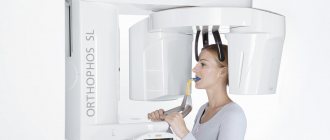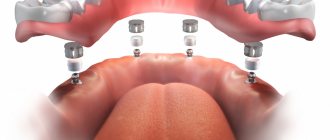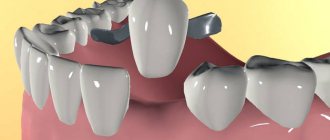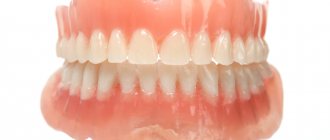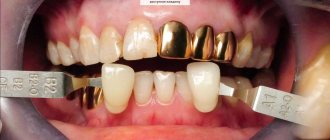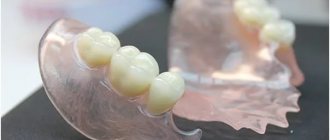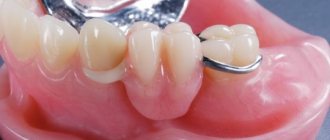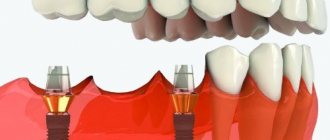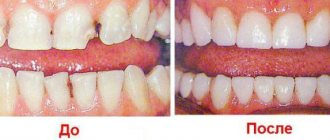What is a beam prosthesis?
The peculiarity of the beam prosthesis is the method of its fixation. The fastening element consists of two parts - a beam and a semicircular metal pipe. The beam connects the implants, the pipe is inserted inside the prosthesis. When fixed, it is put on the beam and latched with a special lock.
Bar dentures are conditionally removable; for daily hygiene it does not need to be removed from the oral cavity. The structure should be removed when visiting the dentist for thorough cleaning or replacement.
What does the beam fixation system consist of?
The system has two parts: removable and non-removable. The latter is a beam connected to crowns, which are installed on the supporting teeth. The acceptable height of artificial teeth is about 8–12 mm. If this parameter is reduced, then difficulties may arise when placing crowns over the sleeve, as well as fractures and cracks of the prosthesis on the vestibular side.
The prosthetic base (saddle) is equipped with a metal matrix, which exactly repeats the shape of the beam and plays the role of a stabilizer and retainer. The beam is attached in an arched, frontal-sagittal, sagittal or frontal manner. Structures of different sections can be used.
Implantation and prosthetics
Since the bar prosthesis is installed supported by implants, treatment of edentulousness can take a long time. The whole procedure takes place in several stages:
- Diagnostics and preparation. At the first stage, the doctor conducts a preliminary examination and prescribes diagnostic procedures. Sometimes consultation with specialists in related fields is required. One of the tasks of this stage is to identify contraindications. The beam prosthesis is fixed to implants, therefore, if the patient has contraindications to implantation, another prosthetic method is selected.
- Operation planning. A beam prosthesis with complete edentia is installed on 4, 6 or 8 implants. For partial edentia, 2 or 3 implants are used depending on the length of the area. At the planning stage, the location of the implants is determined. Since the implantologist has enough degrees of freedom when choosing the implantation site, bar prosthetics in most cases makes it possible to do without bone grafting and restoration of bone volume.
- Preparing for surgery. At this stage, the identified diseases are treated and the oral cavity is sanitized. In case of complete edentia, this step may not be required.
- Dental implantation. In accordance with the treatment plan, implants are implanted, which are then joined together with a beam. The operation is most often performed using traditional technology, in two stages. In some cases, the doctor may recommend immediate implantation. In this case, after implantation, an inexpensive temporary prosthesis is immediately installed.
- Installation of the prosthesis. The prosthesis can be installed only after the implants have completely healed. Typically, osteointervention is achieved in 3-4 months on the lower jaw and 6-7 on the upper jaw. First, the implantologist will place the abutments and connect them with a bar. Then impressions are taken, from which a dental technician will make a prosthesis in the laboratory. Fitting usually takes place within a week. If necessary, the prosthesis is adjusted and adjusted. After adjustment, it is fixed on the beam.
This completes the procedure. The specialist will give you recommendations on how to care for your prosthesis.
Conditionally removable prosthesis on implants: reviews
We have already said above that conditionally removable dentures on implants are fixed using special locking fasteners. Half of each such lock is screwed into the implants and protrudes above the surface of the gum mucosa, and the second half is installed in the base of the denture (in the projection of the installed implants).
When putting on the prosthesis, the parts of the locking fasteners are connected and the prosthesis is securely held. To then remove such a prosthesis, you need to apply a force equal to an approximate lifting of a mass from 400 to 2000 grams (depending on the type of attachment). An overdenture can have several types of fixation to implants, which we will describe in detail below...
Advantages
- The ability to restore the dentition even with complete edentia on both jaws.
- The bar prosthesis is securely fixed with a locking connection on the bar, so there is no need to grab the gum. Thanks to this, the prosthesis is smaller and lighter than a traditional one, so it is more comfortable to wear and does not cause discomfort.
- Thanks to the beam, the chewing load is evenly distributed. There is no risk of injuring your gums, and there is no risk that the denture will move while eating.
- If necessary, the prosthesis can be easily replaced without harming the implants.
- Ease of daily oral and denture care.
- Minimal risk of bone tissue atrophy. Despite the fact that the prosthesis is fixed to several prostheses, they are connected to each other by a metal beam. The beam not only takes on the vertical load, but also distributes it evenly. As a result, the entire bone tissue is loaded, and not just at the implant site.
- More affordable cost of implantation and prosthetics. The bar prosthesis is fixed on 4-8 implants, which reduces the cost of the operation.
- Service life is about 10 years.
- Maintainability. If the prosthesis is damaged, it is easily replaced with a new one. Removing the bar does not affect the implants; they remain undamaged and a new prosthesis can be easily installed on them.
How many implants are needed?
The optimal number of implants is four per jaw . Allows you to correctly distribute chewing loads, avoid atrophy of bone tissue under the prosthesis, and increase the stability and efficiency of the entire structure.
We do not recommend a smaller number - in this case, implants are installed only in the frontal zone, the length of the beam is small. Accordingly, the prosthesis will be unstable in the lateral sections; constant balancing will lead to overload of the implants.
Sometimes six implants may be required for the upper jaw - the bone is softer and looser, so more supports are installed so that the load is distributed evenly.
Flaws
- The operation takes a long time. The prosthesis can be installed only after complete osseointegration of the implants, and this requires about six months.
- Some modern materials are not suitable for the manufacture of bar prostheses.
- The beam is made of metal, so some patients may experience an allergic reaction. Such situations are a special case of contraindications (individual intolerance to materials). In most cases, modern dental alloys do not cause allergies.
- High cost of bar denture design. Despite the fact that restoring the dentition in this way is cheaper than classical implantation, the prosthesis is expensive.
Contraindications to implantation
- Severe pathologies of the cardiovascular system
- Poor blood clotting
- Bone diseases
- AIDS, HIV
- Oncology
- Diabetes mellitus (uncompensated)
- Allergy to materials used to make prostheses and implants
- Age up to 18 years
- Dental and periodontal diseases
- Alcoholism, drug addiction
- Pregnancy and breastfeeding
Important: contraindications are identified by the implantologist after conducting a visual and hardware examination of the patient, as well as collecting an anamnesis. The network of clinics “Smile” is equipped with modern diagnostic equipment. High accuracy of reading parameters and detailed visualization allow our doctors to make the diagnosis as accurately as possible.
Caring for bar dentures
In order to extend the life of the beam prosthesis, it must be properly cared for. You will receive aftercare instructions after completing the procedure.
- Bar dentures are classified as conditionally removable. They do not need to be removed every day. Daily hygiene is no different from caring for your own teeth. The denture should be cleaned with a toothbrush twice a day, and your mouth should be rinsed after eating.
- Once a month, you need to do a more thorough cleaning of the prosthesis, bar and top of the implants. To do this, the prosthesis must be removed. Fixation on the beam is highly durable, but the prosthesis can be removed very easily.
It is enough to follow simple rules and regularly visit the dentist for examination so that no problems arise while wearing a denture.
Content
- What is a “Beam Prosthesis on Implants”?
- Installation of bar dentures on implants
- Advantages and disadvantages of beam prosthetics
- Cost of beam prosthetics
- What alternatives are there to bar dentures?
- How to care for bar dentures?
What is a “Beam Prosthesis on Implants”?
From the name of this prosthesis it follows that the main structural element is a beam that takes on the entire vertical load. In the field of orthodontics, this load is chewing, transmitted from the jaw to the prosthesis and to the installed implants. The same beam, which has provisions for attaching the orthopedic system, helps to obtain the same pressure on all implants. The prosthesis has special recesses in the form of a beam: when joining two composite elements, special mechanisms slam shut, guaranteeing reliable and durable fastening. As a result, beam fixation is capable of completely restoring both an entire row of teeth and a pair of missing teeth on one of the jaws.
Important: The beam prosthesis belongs to the category of conditionally removable structures, but it needs to be removed infrequently, only when the prosthesis needs to be cleaned or replaced.
Indications for the installation of a beam prosthesis are as follows:
- Lack of several teeth in the lower or upper jaw or an absolute lack of dentition;
- It is unattainable to use a conventional removable prosthesis or implement a traditional implantation technique.
Installation of bar dentures on implants
The first stage is the detection of contraindications. Before starting the procedure for installing a bar prosthesis, the dentist needs to make sure that the client has no contraindications to implantation. If such reasons do not allow the installation of dental implants exist, then instead of beam prosthetics, classical prosthetics occurs.
The second stage is the implantation of titanium roots. We have already said that in many situations, bar dentures are installed when there is more than a single deficiency of teeth. To begin with, a surgical intervention occurs in which the beam prosthesis is attached to four implants, but in certain situations, their number can be six or even eight.
Important: Under any circumstances, at least three roots will be required to place one beam prosthesis, otherwise the structure will not be securely fixed. When it is necessary to restore several teeth sequentially, then two or three implants are implanted at the edges, which are joined together using a beam.
The third stage is the production of the prosthesis. At the end of the second stage, impressions are taken and all preparatory operations for dental prosthetics are carried out. On average, the production of beam prostheses does not take more than one week after taking an impression and processing it in the laboratory.
Advantages and disadvantages of beam prosthetics
At the moment, beam fixation has a lot of positive qualities, thanks to which this method of dental prosthetics is a leader among others. The benefits are as follows:
- There is a chance to restore the entire dentition;
- There is no feeling of discomfort, because prostheses connected to implants are much smaller than classical ones, because Such designs do not require gum gripping for attachment. The strong fastening of the beam prosthesis and its ability to distribute the chewing load make it possible to accept products of absolutely any hardness without fear that the prosthesis will move;
- Lower cost of the procedure, because The implant is not fixed on each tooth, but gradually throughout the entire jaw;
- Complete immobility of the prosthesis, which allows you not to worry that the structure will fall out while eating or talking;
- Replacing the prosthesis is very simple and without causing damage to the implants;
- Easy care of the prosthesis.
The disadvantages of installing a bar prosthesis on implants are that:
- The treatment period is quite long, because implant healing takes place over a long period of time;
- You cannot use reliable and aesthetic structures made of zirconium dioxide or ceramics;
- The service life of such prostheses is 10 years.
Cost of beam prosthetics
The cost of services for installing beam prostheses in Moscow clinics can vary greatly from each other due to a huge number of reasons. To begin with, the cost of treatment is mainly based on the number of implants installed, since the titanium root and the procedure for its implantation require the bulk of the investment from the client. The average cost of a prosthesis for one jaw is approximately 330,000 rubles. This amount involves an examination, consultation with a specialist, installation of four to six implants, taking an impression, production of a beam and structure. Prosthetics for several teeth have a lower cost and will amount to about 130,000 rubles.
Most dentists have various promotions that make it possible to install a beam prosthesis on turnkey implants. An individual treatment process is developed for the client, during which implants from a specific company are installed and the prosthesis is secured. This service will help save a significant amount of money, because the cost of installing turnkey beam prostheses is significantly lower than the price without a promotion.
What alternatives are there to bar dentures?
The main alternative to a beam prosthesis is express implantation, during which a permanent prosthesis is placed within a couple of days after implantation of the roots. However, this type of prosthetics costs several times more, but, in any case, it is less expensive than traditional implantation due to the reduced number of stages and processes and the use of affordable prostheses made of plastic and metal.
Mini-implantation is the cheapest alternative to bar prostheses. To restore all missing teeth, four implants are used on top and bottom, which are the anchor points necessary to attach the prosthesis. But experts have identified low reliability of fastening on mini-implants and consider beam prostheses to be of the highest quality. In addition, the duration of use of mini implants is much lower.
Important: Taking into account the advantages and disadvantages of each alternative to bar prostheses, it becomes clear that no one technique can be universal for every situation. The client must consult with a specialist and choose the most reliable and safe method of dental prosthetics.
How to care for bar dentures?
Taking good care of your bar dentures is not difficult. In the case of ordinary removable dentures, daily procedures should be carried out to clean them from pieces of food and bacteria, and rinse them in special liquids. But beam prostheses are convenient because there is absolutely no need to remove them every day. Care is very simple: you just need to clean the dentures twice a day with a toothbrush and toothpaste without removing them, that is, carry out the same manipulation as with real teeth. But once a month it is recommended to remove the prosthesis for detailed cleaning of the structure, its beam and the upper part of the implants.
Important: You need to know that beam fixation is somewhat more expensive than many others, but much stronger and more durable. In addition, if the fastening system is damaged, it is very easy to replace it with a new one.
Price of beam prosthetics
The cost of beam prosthetics is influenced by various factors, so it may vary even in the same clinic. Main factors:
- Type of implants. Implant systems can vary greatly in price. Our clinic uses different implants, and our orthopedist will choose the most suitable option for you.
- Number of implants. For complete edentia, at least 4 implants are required, for partial edentia, at least two. The smaller the number of implants, the cheaper the operation will cost.
- Additional dental procedures. In preparation for the operation, you will undergo a full diagnosis, treatment of identified dental problems, and sanitation of the oral cavity. The list of manipulations will influence the final price of beam prosthetics.
- Cost of beam and prosthesis.
How is prosthetics performed?
Prosthetics using a clasp design is quite lengthy and complex, but justified by excellent results. The first stage of treatment is a thorough clinical examination. The dentist conducts an examination, assesses the topography and size of the dentition defect, the condition and position of natural teeth. The type of occlusion, interalveolar distance, nature of teeth closure and other factors that may affect the success of treatment are determined. The patient is prescribed additional research methods (radiography, CT).
At the next visit, the specialist makes an accurate diagnosis and selects a suitable clasp prosthesis. The patient is informed about fixation methods and chooses the desired one. The dentist takes individual impressions of the jaws and passes them on to the dental technician.
In the dental laboratory, jaw models are cast, examined, and the future design is modeled. Several oral fittings are required during the manufacturing process. The finished structure is handed over to the dentist. The doctor tries on the prosthesis in the mouth and tells the patient how to put it on and take it off. Gives recommendations for use and hygienic care.
